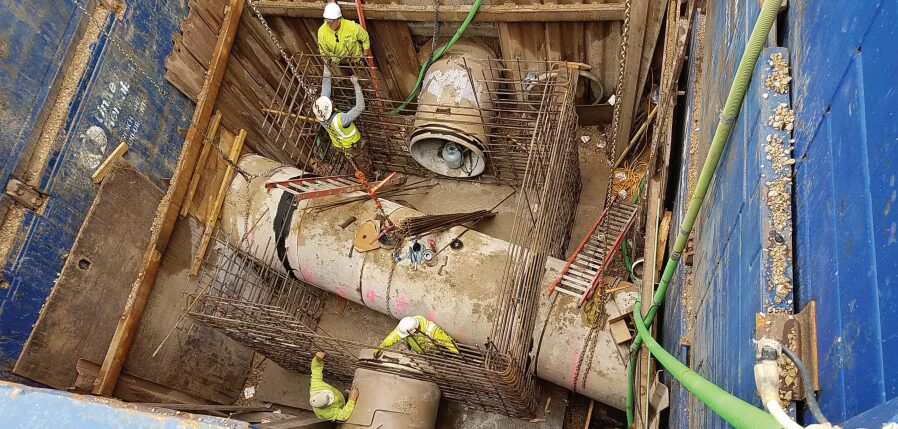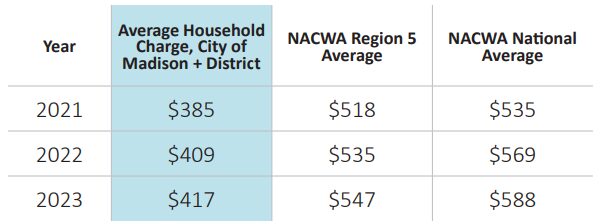
Madison Metropolitan Sewerage District has significant capital infrastructure needs for the foreseeable future.
In 2025, nearly two-thirds of these infrastructure needs are driven by condition and aging infrastructure, and another approximately one-third to address capacity needs. While most construction projects are funded by low-interest state loans, we must increase rates to cover loan payments, cash-funded projects and upfront costs. Rate increases also support growing operating and maintenance costs to support wastewater treatment.
For 2025, the District has adopted a budget that directly addresses these challenges of aging infrastructure and needed capacity while also meeting owner communities’ request to slow the pace the service charge increases.
The bottom line: Household impact*

Benchmarked against the region and the nation, the District’s household impact continues to trend below average.
- $281 for 2025 annual charges from the District
- $13.95 more per year over 2024
- 5.2% more per household
*Based on the 2025 budget proposed on September 12, 2024, revised on October 17, 2024 and adopted on October 31, 2024.
Why costs are increasing
Aging infrastructure and condition
- Most sewer infrastructure lasts 40 to 50 years.
- If we don’t repair or replace old infrastructure, we risk sewer overflows and higher contaminant levels in treated wastewater.
- About 70% of the District’s collection system, by length, was installed in the 1960s and 1970s.
- A significant portion of the District’s treatment plant infrastructure was built in the 1970s and 1980s, with free money in the form of state and federal grants.
Items in the 2025 budget to address aging infrastructure:
- Electrical equipment: Replace critical electrical gear that powers the treatment plant.
- Wastewater treatment equipment: Replace air piping, diffusers, blowers and other key equipment need to treat wastewater.
- Northeast sewer near airport: Repair of corroded sewer pipes installed in 1969 to improve wastewater flow and avoid costly replacements later.
- Adding Operator and Collection System Engineer positions to address frontline Operations & Maintenance needs.
Population growth and capacity
- Dane County is this fastest-growing county in Wisconsin.
- As more people move in, we need to add more pipes and pumps to bring wastewater to the treatment plant.
- Population growth also results in new businesses with special wastewater disposal needs.
- On the positive, population growth helps spread cost.
- Without these additions, there’s a higher risk of sewage backups in basements.
Some items in the 2025 budget to address population growth:
- West Interceptor: Install 11,500 feet of new sewer to support growth in Middleton and Westport.
- Pumping Station 17: Increase capacity to pump wastewater from Verona to treatment plant, supporting growth in this area.
- Northeast Interceptor: Install 16,500 feet of new sewer for growth in Waunakee and Westport.
- New Waste Acceptance Coordinator position to address increased business demand for special wastes and address regulatory requirements.
Other cost drivers of note
- Various Operations & Maintenance needs totaling $1.5 million, including:
- Portable generator to assist owner communities in running their pumping stations in the event of power outages.
- Televising inspection and cleaning hard-to-reach areas of the collection system to check pipe condition and proactively identify issues.
- Potential for use of general obligation bonds, which come with higher interest rates.
- The District typically relies on low-cost Clean Water Fund loans for capital projects; however, this program is likely oversubscribed for 2025, which may press the District to use bonds to fund critical projects.
2025 budget investment benefits
These projects bring important benefits to our community, making sure our sewer system works well now and in the future:
- Improved public health and safety: By expanding and upgrading our sewer system, we lower the risk of sewage backups and overflows. This helps keep our homes and neighborhoods safe and clean and supports our growing communities.
- Protecting the environment: Updating our old pipes and equipment helps keep harmful substances out of our lakes and streams. These improvements protect our natural resources and keep our environment healthy.
- Saving money over time: Repairing, replacing and and upgrading our treatment plant and collection system infrastructure now instead of deferring it will save money in the future. By taking care of problems early, we can avoid more costly emergency repairs and keep the system running smoothly for years to come.
Find the District’s 2025 budget at madsewer.org/2025-budget.






